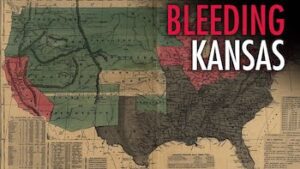
*Black History and Bleeding Kansas are affirmed on this date in 1854. Bleeding Kansas, or the Border War, was five years of violent civil confrontations in Kansas Territory and western Missouri, a slave state since 1821.
The conflict centered on whether Kansas would join the Union as a slave or free state. The question was important because Kansas's two new senators would affect the balance of power in the U.S. Senate over slavery. The abolitionist movement gained increasing prominence in the United States, and tensions between its followers and critics escalated; the U.S. Congress maintained a fragile balance of power between Northern and Southern representatives.
At the same time, the increasing emigration of Americans to the country's western frontier and the desire to build a transcontinental railroad that would connect the eastern states with California urged the incorporation of the western territories into the Union. The inevitable question was how these territories would treat the issue of slavery when eventually promoted to statehood. This question had already plagued Congress during political debates following the Mexican–American War. The Compromise of 1850 had at least temporarily solved the problem by permitting residents of the Utah and New Mexico Territories to decide their laws on slavery by popular vote. This act set a new precedent in the ongoing debate over slavery.
The Kansas–Nebraska Act created new territories of Kansas and Nebraska for settlement by white-Americans. The act was a way to appease Southern representatives in Congress, who had resisted earlier proposals to admit states from the Nebraska Territory because of the Missouri Compromise of 1820, which had explicitly forbidden the practice of slavery in all U.S. territory north of 36°30' latitude and west of the Mississippi River, except in the state of Missouri. The Act of 1854 also called for popular sovereignty: the decision about slavery would be made by popular vote of the territory's settlers rather than by legislators in Washington, D.C.
Kansas had a state-level civil war. It had two capitals (proslavery Lecompton and antislavery Lawrence, then Topeka), constitutions, and legislatures. Both sides sought and received help from outside. After much commotion, including a congressional investigation, it became clear that most Kansans wanted Kansas to be a free state, but this required congressional approval, which Southerners in Congress blocked. The Bleeding Kansas conflict was years of electoral fraud, raids, assaults, and murders in the Kansas Territory and neighboring Missouri by proslavery "border ruffians" and retaliatory raids carried out by antislavery "free-staters."
According to the Kansas Historical Society, there were 56 to 200 political killings documented during the period. Kansas was admitted to the Union as a free state. Partisan violence continued along the Kansas–Missouri border for most of the War, although Union control of Kansas was never seriously threatened. Bleeding Kansas demonstrated that armed conflict over slavery was unavoidable. Its severity made national headlines, which suggested to the American people that the sectional disputes were unlikely to be resolved without bloodshed, and it, therefore, acted as a preface to the American Civil War. The episode is commemorated with numerous memorials and historic sites.